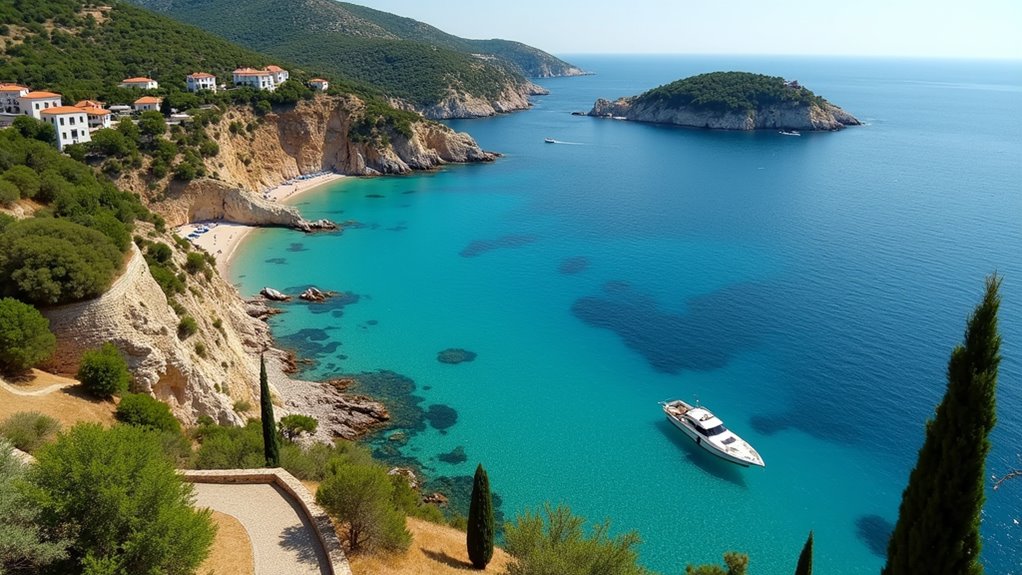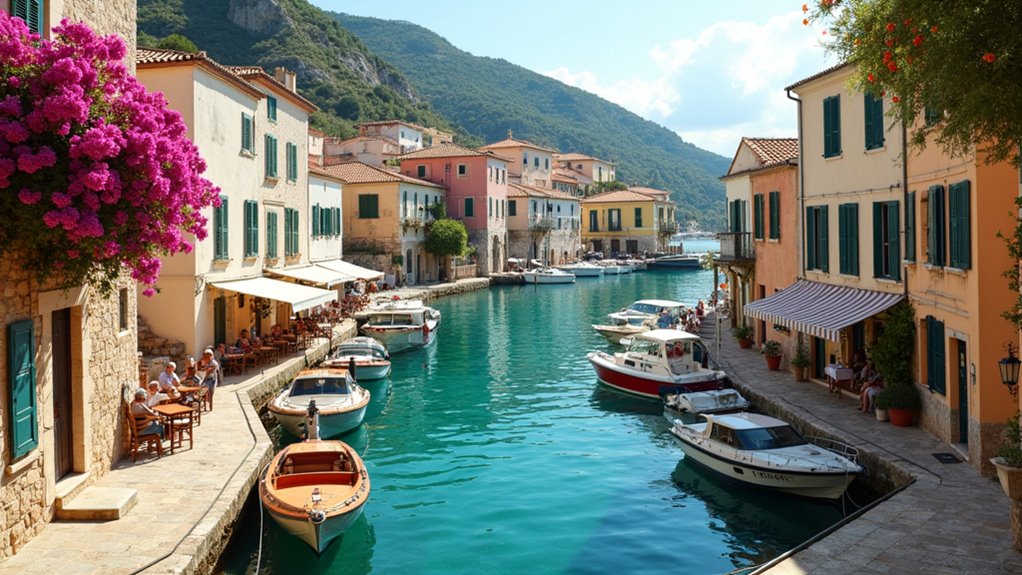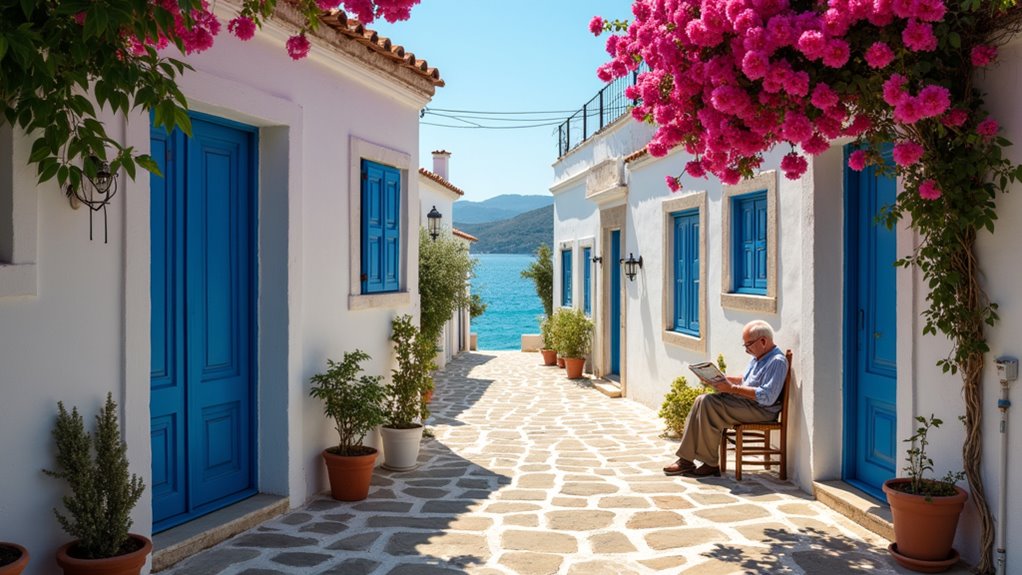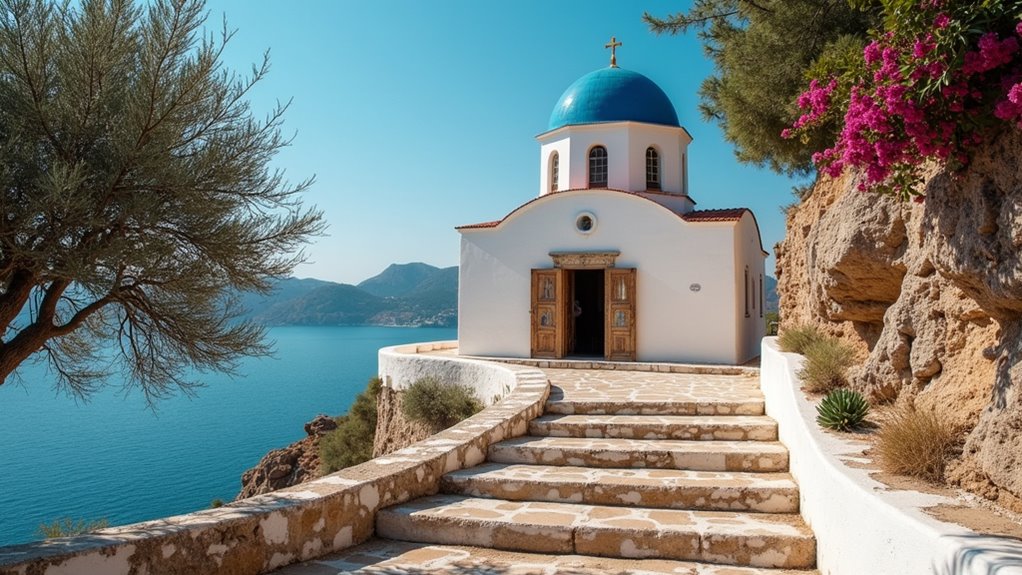Physical Address
304 North Cardinal St.
Dorchester Center, MA 02124
Physical Address
304 North Cardinal St.
Dorchester Center, MA 02124

Discover Paxos' hidden treasures beyond the tourist trail, where ancient olive groves and emerald waters await your Mediterranean escape.
Looking for a hidden gem in the Mediterranean that hasn’t been overrun by travelers? Paxos, Greece might be your perfect escape. This small Ionian island packs a surprising punch with its limestone caves, emerald waters, and car-free villages that feel frozen in time. You’ll find yourself wandering through olive groves older than most countries and dining at family tavernas where recipes span generations. But what makes Paxos truly special goes beyond these picturesque qualities—it’s something you’ll need to experience firsthand.

When you set foot on the pristine shores of Paxos, the Blue Caves should top your must-see list. These breathtaking limestone formations along the west coast aren’t just pretty—they’re spectacular natural wonders shaped by millions of years of erosion.
You’ll need to hop on a boat to reach them, as they’re only accessible by sea. The journey takes approximately 3 hours round trip from Corfu, offering spectacular views along the way. Many visitors spot dolphins during the journey, adding unexpected magic to the adventure.
While exploring the vibrant blue waters surrounding the caves, don’t miss the crystal-clear swimming spots and white sandy beaches of nearby Antipaxos. Bring your snorkeling gear to discover the diverse marine life beneath the surface.
After a day of exploration, indulge in signature cocktails at one of the charming waterfront bars that dot the island’s harbors.
The rugged coastline offers plenty of secluded spots where you can escape crowds and soak in Paxos’s natural beauty.
Beneath the olive groves and limestone cliffs of Paxos lies an engineering marvel often overlooked by casual visitors—the island’s ancient cistern network. These underground reservoirs tell a fascinating story of survival spanning Roman, Venetian, and British eras.
Hidden below Paxos’ idyllic landscape, ancient cisterns reveal ingenious survival strategies across millennia.
You’ll find rectangular chambers supported by stone pillars at Ag. Apostoloi, featuring decorative elements that blend utility with artistry. The impressive structure holds 600 m³ capacity and was constructed between 1825-1846, making it the second-largest cistern on the island. Don’t miss the Agios Nikolaos fortress cisterns, which once supplied military garrisons and supported Paxos’ maritime security.
These water systems aren’t just practical—they’re architectural treasures. The ingenious designs collected rainwater during dry Mediterranean summers, sustaining entire communities for centuries.
Follow the heritage trails connecting these structures to experience how this tiny island adapted to limited freshwater resources while maintaining its seafaring traditions. Like Athens with its ancient allure, Paxos offers a unique window into Greek history through its carefully preserved archaeological sites.

The three harbor villages of Paxos welcome you with a distinctive blend of Venetian charm and authentic Greek island life. As you stroll through narrow cobblestone streets, you’ll discover pastel-colored houses in Loggos and historic mansions showcasing Ionian architectural style.
Magazia, once the island’s capital during pirate times, invites you to explore its ancient olive groves and the fascinating Olive Press Museum.
In Fontana, you’ll find a 15th-century church and the village’s namesake plane tree gracing its central square. The village is also known as Platanos and features the historic Estavromenos church with remarkable frescoes.
Each village preserves its unique traditions, with life revolving around vibrant squares where locals gather. Like the larger island of Crete’s villages, these harbors maintain a slower pace of life that feels wonderfully disconnected from tourist crowds. Don’t miss the traditional tavernas and kafenions, perfect spots to savor local specialties while gazing at scenic views of the surrounding hilly landscapes and tranquil harbors.
Towering majestically on the western coastline of Paxos, the Tripitos Arch stands as nature’s own sculpture, carved over centuries by the persistent Mediterranean Sea. This impressive 20-meter rock formation sits just 3 kilometers from Gaios, making it easily accessible during your island adventure.
Nature’s timeless artistry on display, where sea meets stone in magnificent harmony
You’ll want to bring your camera – the changing sunlight creates dramatic effects against the stone arch, while crystal-clear waters below reveal vibrant marine life. For the most rewarding experience, visit during sunrise or sunset when the lighting creates optimal scenic views.
Explore the area by boat tour, allowing you to appreciate the full scale of this natural wonder, or hike to view it from land for a different perspective.
The arch isn’t alone – Paxos boasts numerous unique rock formations along its coastline, each telling its own geological story and providing perfect spots for swimming and snorkeling. While Paxos offers a secluded escape, adventurous travelers can also explore Greek islands near Crete for more geological wonders.

While Paxos offers natural wonders like the Tripitos Arch, you’ll quickly notice something else that makes this island special: the blissful absence of traffic jams and car horns. The island’s three main villages—Gaios, Lakka, and Loggos—embrace a pedestrian-first approach with their narrow, winding alleyways.
You’ll adapt to the rhythm of exploring on foot, hopping on a quad bike, or catching one of the 52-seater coaches to reach secluded beaches. No private cars means cleaner air and quieter surroundings. Similar to the Small Cyclades islands, Paxos provides an authentic experience where transportation by boat often replaces the need for cars. Unlike the busy crowds of Mykonos, Paxos maintains a serene atmosphere perfect for those seeking a more relaxed Greek island experience. The strategic parking areas outside village centers preserve the tranquil atmosphere that draws visitors seeking escape.
As night falls, minimal street lighting reveals stunning starscapes—another benefit of Paxos’ commitment to preserving its natural charm and traditional lifestyle.
When visiting Paxos, you’ll quickly discover that food isn’t just sustenance—it’s the heartbeat of island culture. The island’s traditional dishes spring from what’s locally available, with seafood taking center stage in waterfront tavernas throughout Gaios and Loggos. While Paxos offers a more authentic culinary experience, those seeking vibrant party scenes might prefer the energetic atmosphere of Mykonos instead.
You can’t leave without trying:
For a truly authentic experience, visit Erimitis Beach restaurant where you can enjoy gourmet dishes with a romantic sea view while watching the sunset. Most restaurants offer complimentary sweets after your meal, best enjoyed while dining al fresco with harbor views—the perfect end to your culinary adventure.

Despite its small size, Paxos packs an impressive cultural heritage into every corner of the island. You’ll discover 64 historic churches scattered across the landscape, some dating back to the 6th century.
Don’t miss Ypapanti Church with its unique double dome and marble altar—it’s the only Byzantine-style church of its kind on the island. In Gaios, the 15th-century Venetian Fortress stands as a testament to the island’s strategic importance.
Wander through the stone-paved alleys of traditional villages, where neoclassical buildings with tiled roofs showcase the island’s architectural charm. For history buffs, the Archaeological Museum and Paxos Folk Museum offer fascinating glimpses into local heritage.
Time your visit during Holy Week to experience authentic processions through these historic settings. For the most authentic Greek experience, consider traveling during shoulder seasons when crowds are thinner and cultural events are more accessible to visitors.
The Ruins of Early Christian Basilica of Agia Marina near Ozias Beach offer a glimpse into the island’s 1,600-year-old religious history with their partially remaining walls.
You’ve seen seven reasons to visit Paxos, yet isn’t it ironic that the best reason might be what you won’t find there? No crowds, no traffic jams, no tourist traps. While everyone else flocks to Santorini and Mykonos, you’ll be wandering quiet villages and swimming in crystal caves. The island’s simplicity is its luxury. Go ahead, keep Paxos your little secret—or don’t. Your call.